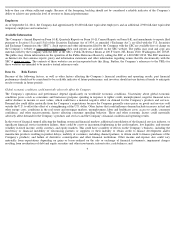Apple 2011 Annual Report Download - page 21
Download and view the complete annual report
Please find page 21 of the 2011 Apple annual report below. You can navigate through the pages in the report by either clicking on the pages listed below, or by using the keyword search tool below to find specific information within the annual report.
regulations, a violation by the Company’
s employees, contractors, or agents could nevertheless occur. The consequences of such violations could
individually or in the aggregate materially adversely affect the Company’s financial condition or operating results.
The Company’
s financial condition and operating results also could be significantly affected by other risks associated with international
activities including, but not limited to, economic and labor conditions, increased duties, taxes and other costs, political instability, and changes in
the value of the U.S. dollar versus local currencies. Margins on sales of the Company’
s products in foreign countries, and on sales of products
that include components obtained from foreign suppliers, could be materially adversely affected by foreign currency exchange rate fluctuations
and by international trade regulations, including duties, tariffs and antidumping penalties. The Company is also exposed to credit and
collectability risk on its trade receivables with customers in certain international markets. There can be no assurance it can effectively limit its
credit risk and avoid losses, which could materially adversely affect the Company’s financial condition and operating results.
The Company’s primary exposure to movements in foreign currency exchange rates relate to non-
U.S. dollar denominated sales and operating
expenses worldwide. Weakening of foreign currencies relative to the U.S. dollar will adversely affect the U.S. dollar value of the Company’
s
foreign currency-
denominated sales and earnings, and generally will lead the Company to raise international pricing, potentially reducing
demand for the Company’
s products. In some circumstances, due to competition or other reasons, the Company may decide not to raise local
prices to the full extent of the dollar’s strengthening, or at all, which would adversely affect the U.S. dollar value of the Company’
s foreign
currency denominated sales and earnings. Conversely, a strengthening of foreign currencies, while generally beneficial to the Company’
s foreign
currency-
denominated sales and earnings, could cause the Company to reduce international pricing and incur losses on its foreign currency
derivative instruments, thereby limiting the benefit. Additionally, strengthening of foreign currencies may also increase the Company’
s cost of
product components denominated in those currencies, thus adversely affecting gross margins.
The Company has used derivative instruments, such as foreign currency forward and option contracts, to hedge certain exposures to fluctuations
in foreign currency exchange rates. The use of such hedging activities may not offset any or more than a portion of the adverse financial effects
of unfavorable movements in foreign exchange rates over the limited time the hedges are in place.
The Company is exposed to credit risk and fluctuations in the market values of its investment portfolio.
Although the Company has not recognized any significant losses to date on its cash, cash equivalents and marketable securities, any significant
declines in their market values could materially adversely affect the Company’
s financial condition and operating results. Given the global
nature of its business, the Company has both domestic and international investments. Credit ratings and pricing of these investments can be
negatively affected by liquidity, credit deterioration, financial results, economic risk, political risk, sovereign risk or other factors. As a result, the
value and liquidity of the Company’
s cash, cash equivalents and marketable securities could decline and result in a significant impairment,
which could materially adversely affect the Company’s financial condition and operating results.
The Company is exposed to credit risk on its trade accounts receivable, vendor non-trade receivables and prepayments related to long-
term
supply agreements. This risk is heightened during periods when economic conditions worsen.
The Company distributes its products through third-party cellular network carriers, wholesalers, retailers and value-
added resellers. A substantial
majority of the Company’s outstanding trade receivables are not covered by collateral or credit insurance. The Company’
s exposure to credit and
collectability risk on its trade receivables is higher in certain international markets and its ability to mitigate such risks may be limited. Cellular
network carriers accounted for a significant portion of the Company’s trade receivables as of September 24, 2011. The
19
























